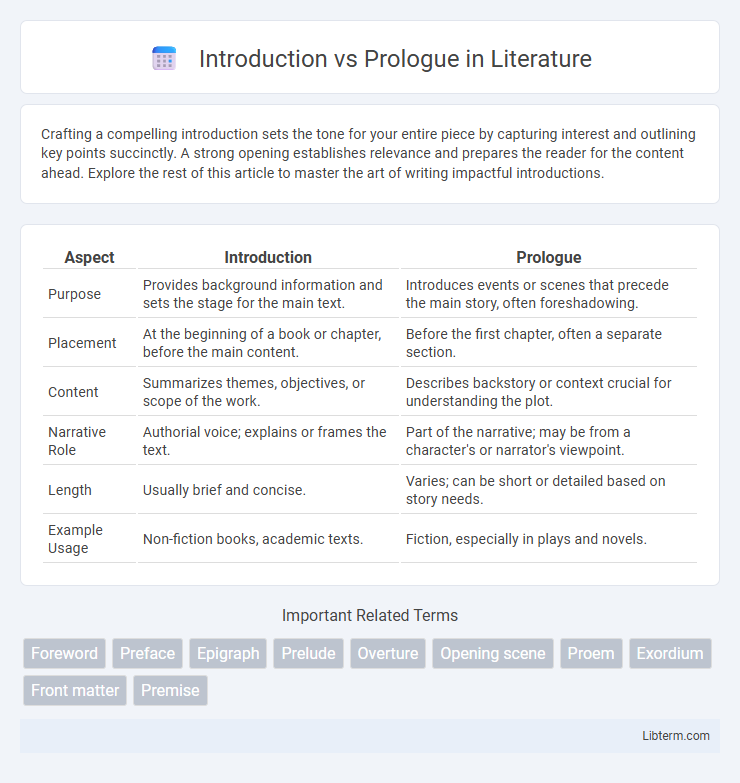Crafting a compelling introduction sets the tone for your entire piece by capturing interest and outlining key points succinctly. A strong opening establishes relevance and prepares the reader for the content ahead. Explore the rest of this article to master the art of writing impactful introductions.
Table of Comparison
| Aspect | Introduction | Prologue |
|---|---|---|
| Purpose | Provides background information and sets the stage for the main text. | Introduces events or scenes that precede the main story, often foreshadowing. |
| Placement | At the beginning of a book or chapter, before the main content. | Before the first chapter, often a separate section. |
| Content | Summarizes themes, objectives, or scope of the work. | Describes backstory or context crucial for understanding the plot. |
| Narrative Role | Authorial voice; explains or frames the text. | Part of the narrative; may be from a character's or narrator's viewpoint. |
| Length | Usually brief and concise. | Varies; can be short or detailed based on story needs. |
| Example Usage | Non-fiction books, academic texts. | Fiction, especially in plays and novels. |
Understanding Introductions and Prologues
Introductions provide essential context, outlining the scope, purpose, and structure of a work to prepare readers for the content ahead, while prologues are narrative segments that set the scene or backstory within the story itself. Understanding introductions involves recognizing their role in orienting readers to themes and objectives, whereas prologues enhance plot development by offering crucial pre-story information or perspectives. Both elements contribute to reader engagement but serve distinct functions in framing and enriching the reading experience.
Defining the Introduction
The introduction serves as the opening section of a book or article, providing essential background information and setting the context for the main content. It outlines the purpose, scope, and structure of the text, helping readers understand what to expect. Unlike a prologue, which typically offers narrative or thematic prelude, the introduction primarily focuses on orienting the reader with factual and conceptual groundwork.
What Is a Prologue?
A prologue is a distinct opening section of a literary work that provides background information or sets the stage for the main story, often featuring events that occur before the narrative timeline. Unlike an introduction, which typically offers commentary or context about the book itself, a prologue immerses readers directly into a scene or plot element essential to understanding the story. Prologues are common in novels, plays, and epic poetry, enriching the narrative by revealing key details or perspectives that enhance the reader's experience.
Core Differences: Introduction vs Prologue
An introduction serves to present the main themes, purpose, or background of a text, often written by the author or editor to guide reader comprehension. A prologue, in contrast, is a narrative section preceding the main story, offering context, setting, or preliminary events that directly relate to the plot. Core differences lie in function and content: introduction is expository and external, while prologue is narrative and integrated within the story structure.
Purpose and Function in Storytelling
An introduction in storytelling serves to set the stage by providing essential background information, context, or framing for the narrative, often guiding readers directly into the main story. A prologue functions as a distinct segment that presents events or perspectives separate from the main plot, typically offering key insights, foreshadowing, or foundational details to enhance understanding and engagement. Both elements optimize narrative structure by enriching the audience's comprehension and emotional connection to the story.
When to Use an Introduction
An introduction is used at the beginning of non-fiction books or academic texts to provide context, outline the purpose, and set the stage for the content that follows. It helps readers understand the scope, methodology, and key themes, ensuring clarity before diving into the main material. Unlike a prologue, which is common in fiction to offer background or a narrative hook, introductions are structured to inform and prepare readers for factual or analytical content.
When to Include a Prologue
A prologue is included when background information, context, or events preceding the main narrative are essential for reader understanding and engagement. It often sets the scene for the story's world, reveals a key event, or provides a different perspective that cannot be integrated smoothly into the main chapters. Authors use prologues to enhance plot depth or build suspense without disrupting the flow of the primary storyline.
Common Mistakes with Introductions and Prologues
Common mistakes with introductions and prologues include confusing their purposes: introductions summarize the main content and set expectations, whereas prologues provide background or context, often in a narrative form. Writers often overload introductions with excessive detail meant for the main body or misplace essential story elements that belong in the prologue. Understanding the distinct functions prevents redundancy and enhances the reader's engagement by properly framing the work.
Examples from Famous Books
An Introduction often appears in non-fiction works like *Sapiens* by Yuval Noah Harari, where it sets the stage by explaining the book's scope and purpose, guiding readers through the author's perspective. A Prologue, seen in fiction like *Romeo and Juliet* by William Shakespeare, provides background or context essential for understanding the upcoming narrative, often featuring a short scene or exposition related to the plot. Both serve different functions: Introductions orient readers to the subject matter, while Prologues immerse readers in a story's universe before the main text begins.
Tips for Choosing the Right Opening
Choosing between an introduction and a prologue depends on the story's structure and purpose; introductions often provide background or context directly related to the main narrative, while prologues set up separate scenes or timelines that foreshadow key plot elements. Writers should consider their target audience and the desired pacing, using introductions to orient readers smoothly and prologues to build intrigue or suspense. Evaluating the necessity of early exposition against maintaining narrative momentum helps determine the most effective opening for engagement.
Introduction Infographic

 libterm.com
libterm.com